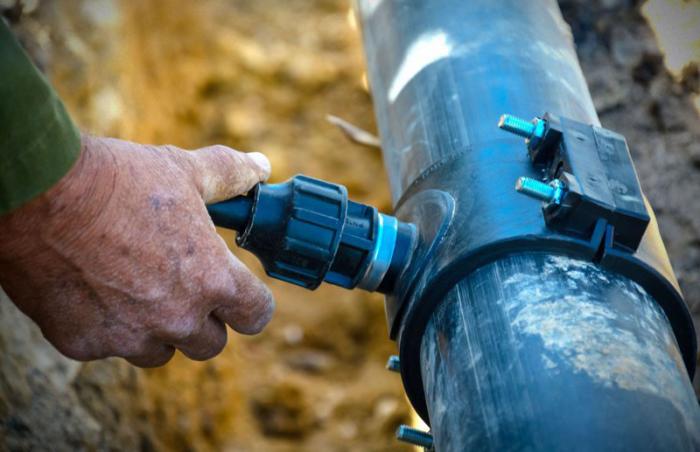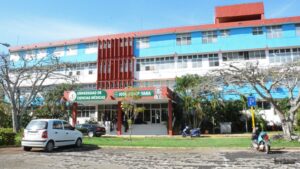Yarielki Aragón Borroto works in Cubatabaco and lives in the village of Florencia, just off the road to Jarahueca, on the way to Sancti Spíritus province. For a few days now, the arrival of water has brought a smile to her face, but she still remembers the past: «The pipe used to arrive reluctantly, or it would slip away to other places, and we had to call the government because we had no water.
«Cycles of more than 20 days, or even 30! You had to plan to do the washing, the laundry, and sometimes you had to do it at a relative’s or neighbour’s house. I tell you that the lack of water can even lead to divorce,» she told Granma.
Those were days marked by drought, because when we talk about it in Ciego de Ávila, we will inevitably have to mention the municipality of Florencia, also known as the municipality of beautiful landscapes, not so beautiful now, when our gaze crashes against the ochre-coloured hills.
There, on top of one of them, three tanks, like sleeping elephants, have been part of the landscape for a few months now. It took a lot of work to raise them to a height of 159 metres above sea level; it also took a lot of work to bring water to every single inhabitant of this municipality in the Turquino-Bamburanao Plan.
In some areas the water comes down at lightning speed, reaching every corner of the houses. Only very specific places have yet to be supplied with water, say the experts, who are working on the completion of the aqueduct that benefits more than 6,000 inhabitants of the village, and whose total investment exceeds 100 million pesos.
In the space of a decade, Florencia has been involved in three extreme droughts: that of 2004, that of 2017 and this year, to call it something like that; in retrospect, the current drought appeared immediately after the subtropical storm Alberto, which brought the «universal deluge» and, in a few hours, the water surpassed the level of the Jatibonico del Norte river.
THE MANY LITTLE BITS OF WATER
The execution of the Florencia aqueduct began in 2017. It was planned in four phases, says Ricardo Cardoso Sospedra, a specialist in Engineering Project Research at the Cuito Cuanavale Hydraulic Works Maintenance and Rehabilitation Company.
First, a network of easily accessible points was created, consisting of 2,100-litre tanks. In the event of an emergency, the population could go to them and get supplies. The work continued with the installation of water networks to all customers.
The third stage consisted of locating sources of supply and then drilling the wells known as Florencia 3 and Florencia 4, linked to two previous pumping stations. It was also decided to give the Liberación de Florencia dam a value of use for the benefit of the population, the specialist argues.
The location of a floating reservoir with its 160 millimetre pipe and two submersible pumps was also planned, which would increase the delivery to 25 litres per second to the water purification units, from which the population would be supplied by gravity.
Dayli Gómez Martín, senior specialist of the project group in charge of the work, summarises in a few words what has cost so much money (almost 100 million pesos) and time to set up: «The process begins at the Liberación de Florencia reservoir, where the catchment work is located on a raft in the deepest part of the dam; then the water is directed through the pipeline that connects the four wells en route, to the tank at 159 metres above sea level, from where the liquid flows down by gravity to the town. In total, there are more than one hundred kilometres of connections, networks, water supply pipes and new connections for the benefit of the more than 6,000 inhabitants of the village.
The entire network has a valve system for operation. The cycle used to take up to 30 days, and is now around seven, with aspirations to reduce it, in accordance with the existing water reserves in the hydraulic complex.
Most of the inhabitants drink the water from the dam mixed with that extracted from the wells. Danicel Cañizares Carbonell, deputy superintendent, explains that, for the operation, the village is divided into two large sectors which, in turn, are divided into four more sectors and a sub-sector.
Initially, the water did not reach sectors three and four, but now it does, after the placement of suction cups that contribute to a successful operation.
In the southern part,» he says, «we have a two- to three-day cycle, depending on the power supply. During the day, pumping is more stable, because of the use of solar panels to extract the water.
The dam, the main source of water supply, is at 58%. With the volume it holds, it will last for three years with rational and controlled use. In June it was 21 % full, in October it reached 72 %.
By this time, opinions are not opposing, as they were some time ago, when the aqueduct was in the testing phase and Marlen and Ada, neighbours of the Florencia people’s council, were talking about why some people got water and others did not.
The fact is that setting up an aqueduct, operating it correctly, takes time and has its magic, from whether or not the liquid reaches the higher areas, or whether the suction cups are in place so that the column can reach level 159 and fill the tanks resting on top of the hill.
This is the response to the call made in April 2024 by the Deputy Prime Minister of the Republic, Inés María Chapman Waugh, and by the President of the National Institute of Hydraulic Resources, Antonio Rodríguez Rodríguez, who emphasised the need to finish the aqueduct as soon as possible, due to the prevailing hydrological drought, and to provide a better quality of life for the inhabitants of this mountainous town.
For this reason, the impossible is being done to ensure that water reaches all the inhabitants, including Mabel, Fita, Lurdes, Olimpia, who, at the time of Granma’s visit, were still not receiving the liquid.
Yordanis Pérez Delgado, director of the ueb Proyectos Hidráulicos, explains: «Operating an aqueduct is no easy task. We are now working on the operation manual to use the different variants to meet the needs of the population. What is certain is that the inhabitants of Florencia will have more water than they have had so far.
THROUGH THE OPEN VEINS OF THE SUBSOIL
The computer of Oscar Monteagudo Brito, technical director of the Empresa de Aprovechamiento Hidráulico Ciego de Ávila, gives an account of the existing reserves in each of the 15 hydrogeological sectors (12 in the north and three in the south) into which the province is divided.
«Sectors five and eight in the north and two in the south are in a very unfavourable state. The first at 13% of full, and the second at 21%, with the aggravating circumstance that, in the case of sector five, it is the tributary of more than 95,400 inhabitants in the northern part of Ciego de Avila; for example, the towns of Ceballos, Ciro Redondo, and part of the city of Morón. The two in the southern part barely store 14% of their total capacity, he says with concern.
The specialist adds that sectors four, six, seven, nine, ten, 11 and 12 are in an unfavourable state. In short, of the 15 sectors, only four are in a favourable phase, a warning not to waste water.
The unhappiness of the drought in Ciego de Avila is due to the deficit of rainfall during the rainy period, from May to October, aggravated by the fact that from May to June, rainfall was below historical records. July, another month of the rainy period, also recorded a rainfall deficit.
The drought event did not start this year. From January 2021 to March 2025, rainfall shows significant fluctuations by month, with some accumulations above the historical average and several consecutive months of well below-average rainfall.
In 35 of the 51 months covered by the stage, rainfall has been below or close to historical records, although there have been isolated very wet months, they were not enough to recharge the aquifers.
Drought is not just a one-off event of lack of rainfall, but a phenomenon that worsens over time, due to multiple interconnected factors that accumulate.
So many times one has seen the level in the wells rise and fall, so many times one has written that water is an exhaustible resource, so many times… and there are still those who do not assimilate that the hydrological drought that the province is suffering from is becoming very harmful for social life, with the maxim that the same people who today clamour for the presence of water are the same ones who squander it.
The water crisis in Ciego de Avila is an example of how the convergence of natural, infrastructural and human factors can lead to the near collapse of a vital service. While the authorities seek technical solutions, there is also an urgent need for an educational campaign to curb waste and social indiscipline. Water does not understand order when man messes up its flow.




